Lamb Bolognese Bianco Recipe
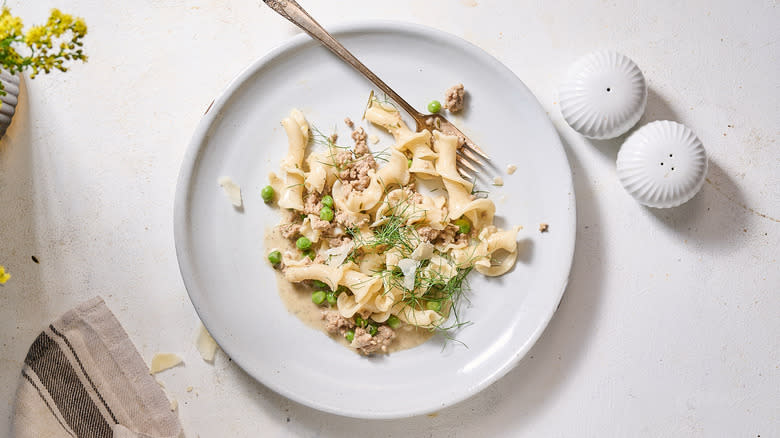
Bolognese is a staple in any pasta-lovers' recipe repertoire. What's not as common is the tomato-less white version, bolognese bianco. Made with cream and Parmesan instead, bolognese bianco is closer to a stroganoff, with a rich flavor and creamy texture. Add lamb, peas, and fennel, like in this recipe developed with Michelle McGlinn, and you have a perfect, silky, springtime pasta. Known for being gamey, lamb can be tricky to add into dishes, especially when paired with delicate flavors like braised fennel. The magic of this dish -- and why you'll want to pick up ground lamb on your next grocery run -- is that the rich sauce balances the meaty lamb flavor, making it versatile enough to pair with tender fennel and springy peas. The dish comes together in an elegant combination of flavors that rival the dishes in your favorite restaurants, all from the comfort of your own home.
Read more: 26 Types Of Pasta Sauce Explained
Gathering The Ingredients For Lamb Bolognese Bianco
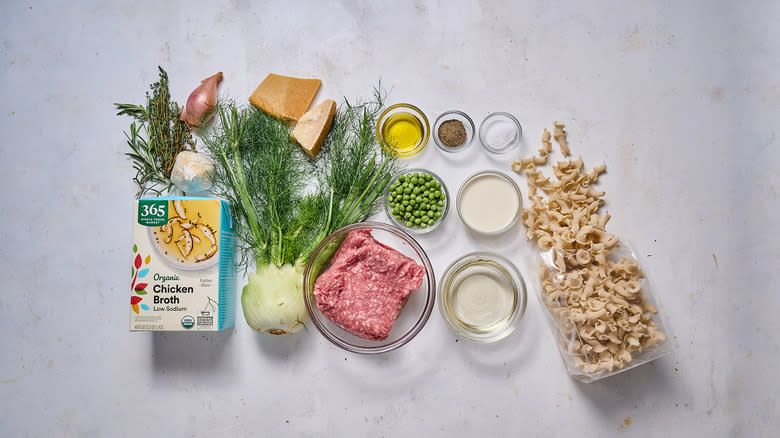
First, gather a few pantry staples -- olive oil, salt, pepper, and garlic. From there, head to the produce section for a medium-sized fennel bulb, fresh peas, a shallot, rosemary, and thyme. Grab your favorite dry white wine, such as sauvignon blanc or chardonnay, and either chicken stock or chicken broth (either will work; you'll just need to adjust your seasonings). You'll need a few dairy items, namely heavy whipping cream, grated Parmesan, and a Parmesan rind. Some stores sell rinds separately, which can be a great way to always have some on hand to throw into soups. Finally, you'll need ground lamb and pasta (we use gigli Toscani) to complete the dish.
Step 1: Prepare Your Pot With Oil
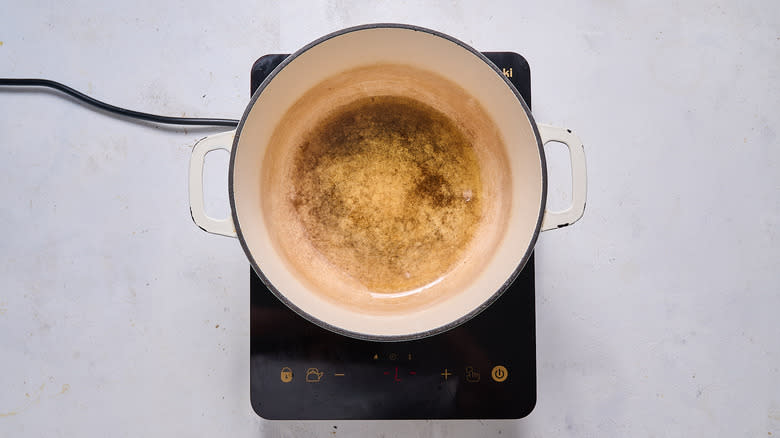
Heat the oil in a Dutch oven over medium heat.
Step 2: Cook And Crumble The Lamb
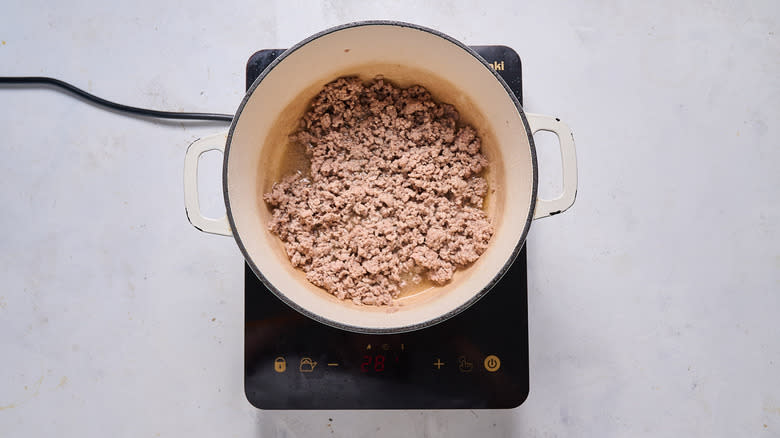
Cook the lamb, crumbling as it browns, for about 5 minutes.
Step 3: Soften The Aromatics
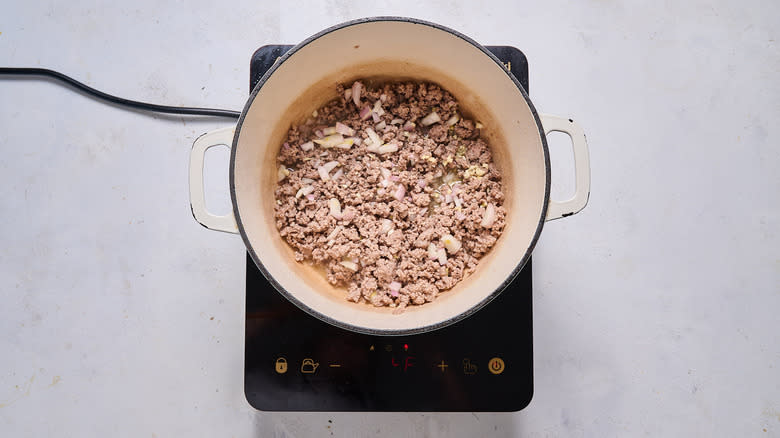
Add the shallot and garlic and cook until fragrant, about 2–3 minutes.
Step 4: Deglaze The Pot
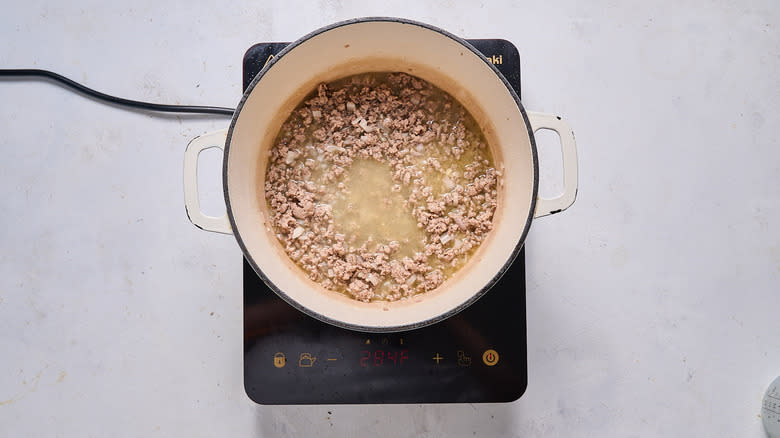
Add the wine and scrape any browned bits from the bottom of the pot. Simmer until the wine is nearly evaporated, about 5 minutes.
Step 5: Add The Seasonings And Stock, And Simmer

Add the rosemary, thyme, salt, pepper, fennel, Parmesan rind, and chicken stock to the pot. Reduce the heat to low, cover, and simmer until reduced to about 1 cup of liquid, about 40 minutes.
Step 6: Cook The Pasta
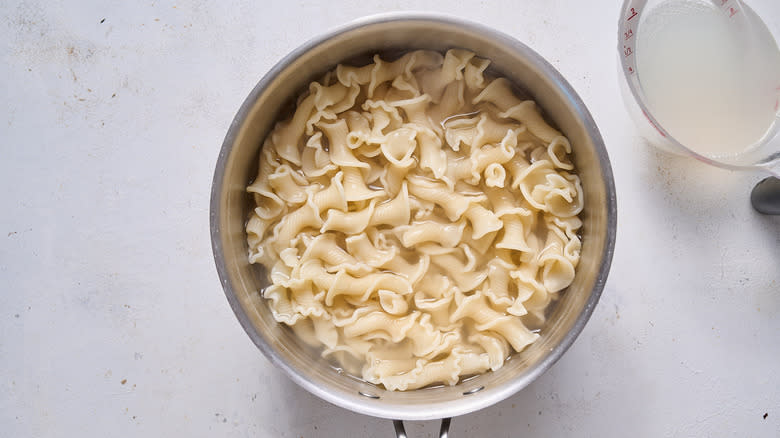
In the meantime, boil the pasta according to package instructions. Reserve 1 cup pasta water, then drain the remaining water.
Step 7: Add The Remaining Ingredients
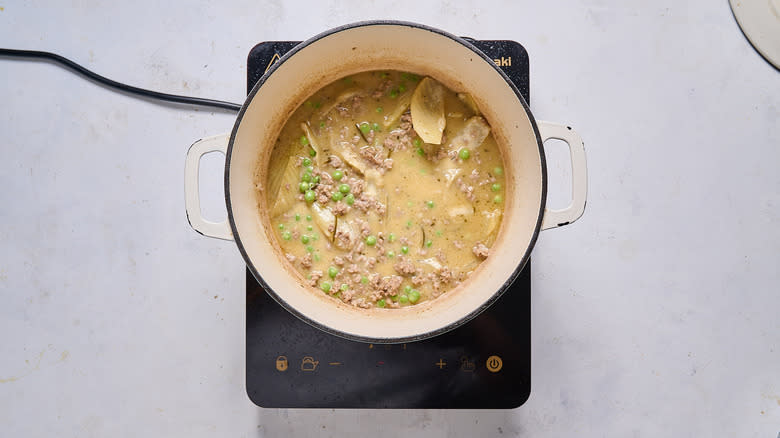
Remove the herbs and rind, then add the peas, whipping cream, and grated Parmesan. Stir to combine.
Step 8: Simmer Until Thick
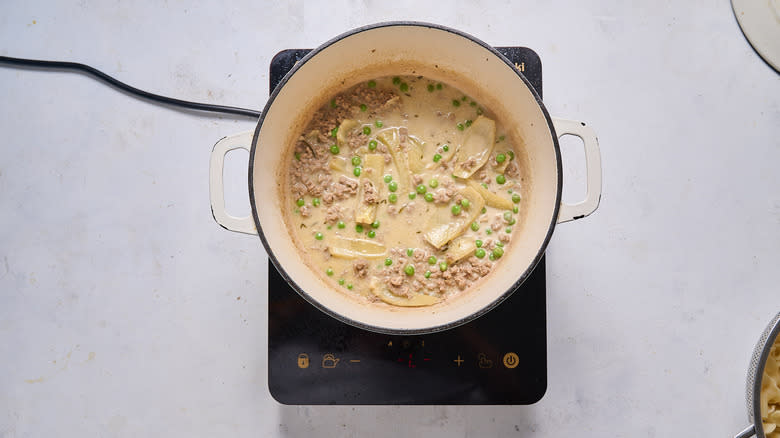
Simmer, uncovered, for an additional 10 minutes, or until thickened.
Step 9: Toss With Pasta And Water
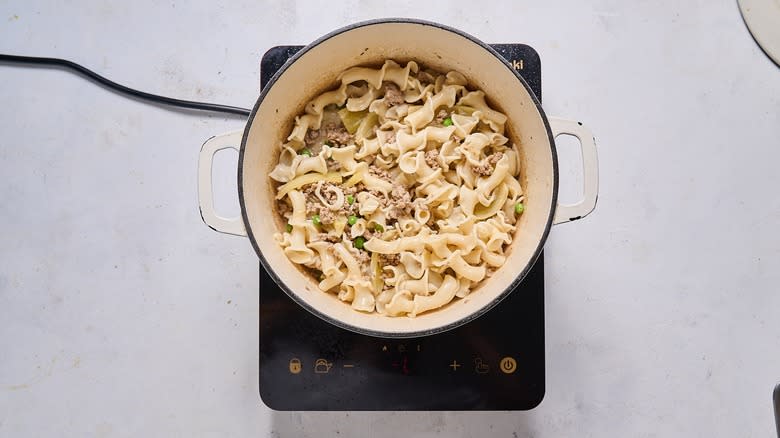
Add the pasta to the bolognese and toss with ½ cup pasta water. If desired, thin the sauce further with the remaining ½ cup water.
Step 10: Top With Fennel Fronds To Serve
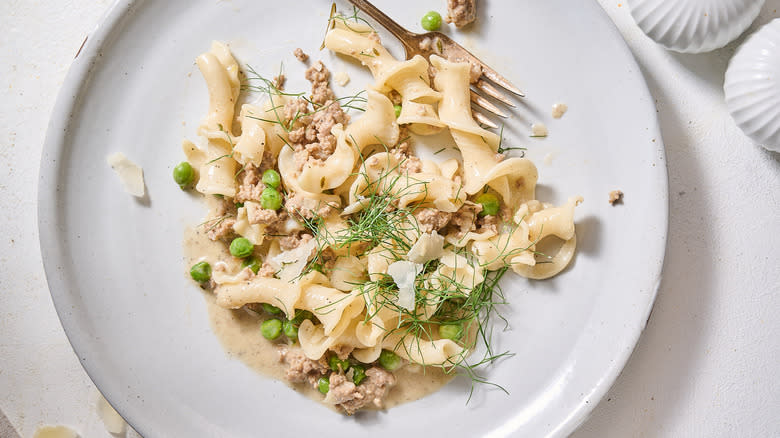
Top with the reserved fennel fronds to serve.
Lamb Bolognese Bianco Recipe
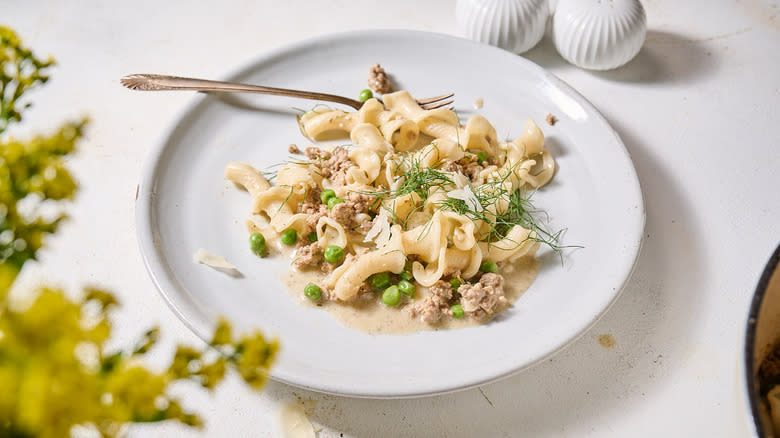
What Pasta Works Best For Bolognese?
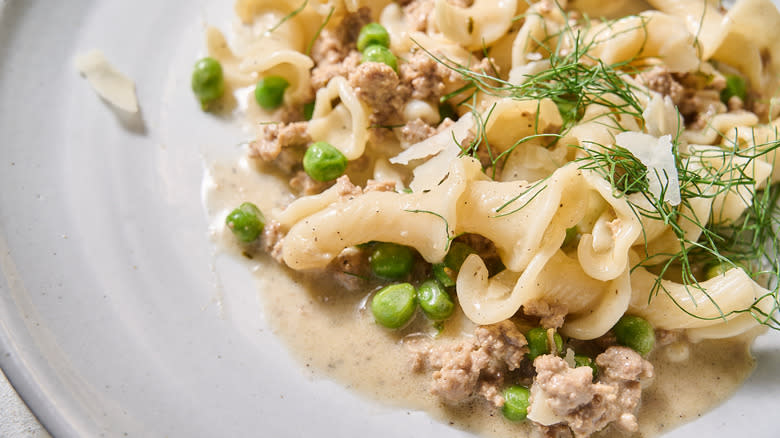
Because it's simmered low and slow, bolognese is a heavy sauce. Whether red or white, bolognese works best with pasta shapes that can hold thick sauces. The pasta shape we use in this recipe, gigli Toscani, is a perfect shape for this particular dish because the spiral shape holds pockets of creamy sauce while the "trumpet"-shaped top catches the peas and lamb pieces. It's also a perfect shape for spearing tender fennel and pasta both on the same fork.
Gigli Toscani, also known as campanelle, isn't a common pasta shape, so if you have trouble finding the intricately spiraled shape, there are a few other pasta types that will be just as good. You can look for other spiral shapes, such as cavatappi, fusilli, or rotini. You can look for similarly short pasta shapes like farfalle or casarecce, or you can also look for classic tube shapes like penne and rigatoni. If you're more of a long-pasta type of person, avoid strand types like angel hair and linguini, which will get mushy in the thick sauce. Instead, try pappardelle or mafalde.
Can I Use A Different Type Of Meat For This Bolognese Recipe?
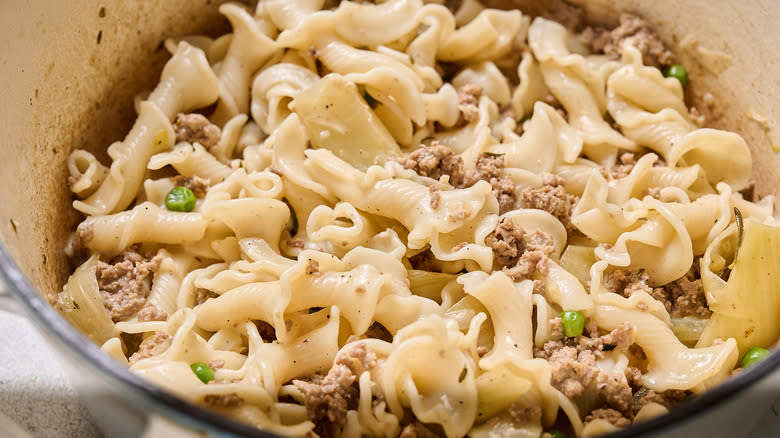
This bolognese bianco is perfectly complemented by meaty, peppery lamb, which has a distinct taste that separates it from beef or chicken. If you can't stand the gamey taste of lamb or simply can't find it in your grocery store, you can swap it for other options. Ground beef and ground chicken will both offer similar results, beef being more meaty and chicken being less rich.
You can also swap in fish, adding the fish at the end instead of in the beginning. Whitefish goes well with bolognese bianco, fennel, and peas, but surprisingly, salmon also fits well into this creamy dish and gives it a Scandinavian feel. To add fish instead of lamb, first sear the fish on either side, then remove it from the heat and continue with the rest of the recipe, beginning at the aromatics. After the sauce has reduced and the cream has been added, add the fish back in to simmer and heat through. Lastly, this dish also makes a great vegetarian option -- just leave the meat out entirely.
Read the original article on Tasting Table.


